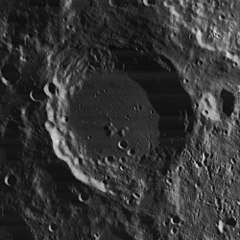Blancanus (crater)
Blancanus is a lunar impact crater located in the rugged southern region of the Moon, to the southwest of the walled plain Clavius. To the northwest lies the comparably sized crater Scheiner, and south-southwest of Blancanus is the worn Klaproth.
 Lunar Orbiter 4 image | |
| Coordinates | 63.6°S 21.5°W |
|---|---|
| Diameter | 105 km |
| Depth | 3.7 km |
| Colongitude | 21° at sunrise |
| Eponym | Giuseppe Biancani |
The outer rim of Blancanus is considerably less worn than that of Scheiner crater to the northwest, and the edge is still fairly well defined and it has a terraced structure on the interior. The floor is relatively flat with several low rises at the midpoint. There is a cluster of small craterlets in the southern part of the crater floor.
Crater Blancanus is named after the Jesuit astronomer and natural philosopher, Giuseppe Biancani (1566–1624).
Satellite craters
By convention these features are identified on lunar maps by placing the letter on the side of the crater midpoint that is closest to Blancanus.
| Blancanus | Latitude | Longitude | Diameter |
|---|---|---|---|
| A | 64.4° S | 21.6° W | 6 km |
| C | 66.5° S | 28.0° W | 46 km |
| D | 63.3° S | 16.5° W | 24 km |
| E | 66.6° S | 21.5° W | 37 km |
| F | 65.1° S | 27.4° W | 9 km |
| G | 63.3° S | 25.3° W | 9 km |
| H | 65.5° S | 23.5° W | 7 km |
| K | 60.6° S | 23.3° W | 11 km |
| N | 63.4° S | 25.8° W | 11 km |
| V | 64.0° S | 20.9° W | 7 km |
| W | 60.9° S | 20.2° W | 9 km |
References
- Andersson, L. E.; Whitaker, E. A. (1982). NASA Catalogue of Lunar Nomenclature. NASA RP-1097.CS1 maint: ref=harv (link)
- Blue, Jennifer (July 25, 2007). "Gazetteer of Planetary Nomenclature". USGS. Retrieved 2007-08-05.CS1 maint: ref=harv (link)
- Bussey, B.; Spudis, P. (2004). The Clementine Atlas of the Moon. New York: Cambridge University Press. ISBN 978-0-521-81528-4.CS1 maint: ref=harv (link)
- Cocks, Elijah E.; Cocks, Josiah C. (1995). Who's Who on the Moon: A Biographical Dictionary of Lunar Nomenclature. Tudor Publishers. ISBN 978-0-936389-27-1.CS1 maint: ref=harv (link)
- McDowell, Jonathan (July 15, 2007). "Lunar Nomenclature". Jonathan's Space Report. Retrieved 2007-10-24.CS1 maint: ref=harv (link)
- Menzel, D. H.; Minnaert, M.; Levin, B.; Dollfus, A.; Bell, B. (1971). "Report on Lunar Nomenclature by the Working Group of Commission 17 of the IAU". Space Science Reviews. 12 (2): 136–186. Bibcode:1971SSRv...12..136M. doi:10.1007/BF00171763.CS1 maint: ref=harv (link)
- Moore, Patrick (2001). On the Moon. Sterling Publishing Co. ISBN 978-0-304-35469-6.CS1 maint: ref=harv (link)
- Price, Fred W. (1988). The Moon Observer's Handbook. Cambridge University Press. ISBN 978-0-521-33500-3.CS1 maint: ref=harv (link)
- Rükl, Antonín (1990). Atlas of the Moon. Kalmbach Books. ISBN 978-0-913135-17-4.CS1 maint: ref=harv (link)
- Webb, Rev. T. W. (1962). Celestial Objects for Common Telescopes (6th revised ed.). Dover. ISBN 978-0-486-20917-3.CS1 maint: ref=harv (link)
- Whitaker, Ewen A. (1999). Mapping and Naming the Moon. Cambridge University Press. ISBN 978-0-521-62248-6.CS1 maint: ref=harv (link)
- Wlasuk, Peter T. (2000). Observing the Moon. Springer. ISBN 978-1-85233-193-1.CS1 maint: ref=harv (link)
